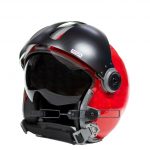The Australian Transport Safety Bureau (ATSB) has issued a Safety Advisory Notice that strongly encourages all pilots conducting low-level operations to wear a properly fitted and maintained flight helmet to improve their survivability in the event of an accident.
The advisory comes as the ATSB releases the final report from its investigation into a wirestrike and collision with terrain accident involving a Robinson R44 helicopter conducting low-level aerial spraying at a property south-east of Hay, NSW in July 2020.
Before commencing spraying at Steam Plains Station, the helicopter pilot received a pre-flight briefing from their chief pilot (who was performing the role of loader that day). The briefing involved a review of hazards on the property including an unmarked 19.1 kV single wire earth return powerline that crossed the perimeter fence line once in the spraying target area. The powerline was also highlighted on the pilot’s map during initial planning with the station manager two days earlier.
When spraying operations commenced, the pilot flew to the property boundary to spray a track adjacent to the fence line from about 2.5 to 5 m above the ground.
On the fifth spray run of the day, and when about 370 m before the position of the identified powerline, recovered data from the helicopter showed that the pilot turned the spray off and manoeuvred the helicopter over a stand of trees 12 to 15 m high. The helicopter then descended, most likely to recommence spraying, when the top of its left skid struck the powerline.
The helicopter then entered uncontrolled flight and collided with the ground about 120 m beyond the wire. The pilot was fatally injured, and the helicopter was substantially damaged.
Post-accident imagery taken by an ATSB remotely piloted aircraft of the helicopter’s flight path found the wire would have been extremely difficult to detect.
“Powerlines, particularly unmarked wires, are normally impossible to see due to the size of the wire, camouflage with the background and limitations of the eye,” ATSB Chief Commissioner Angus Mitchell said.
“Without an aerial hazard check, the pilot was reliant on remembering the location of the wire from earlier briefings and seeing the wire during the flight.”
A review of GPS data found that while the pilot overflew a small section of the spraying area earlier that morning, there had been no aerial inspection to identify potential hazards and to confirm the location of the powerline on the accident flight.
“Even with a map of known powerlines, no matter how many hours of aerial application experience you have, and whether the target area is new to you or you flew it yesterday, a pre-application aerial survey from a safe height should be a non-negotiable piece of your personal commitment to safety.”
The ATSB notes that pilots are increasingly able access to the latest powerline mapping data via applications on their mobile devices. For operations in Queensland, New South Wales and South Australia, pilots can access the location and height of powerlines via the Look Up and Live app, which is available for iOS and Android devices.
In other states and territories, pilots and operators can check with their local energy provider for available powerline information.
The ATSB also encourages landowners who engage pilots to conduct aerial application operations to mark powerlines that may pose a hazard to aircraft.
“As more up-to-date mapping and powerlines data is made available, and more wires carry visible markers, pilots have improved access to tools for planning and strike prevention,” Mr Mitchell noted.
“However, only by conducting an aerial inspection at a safe height can the pilot be assured of the location of hazards.”
During its investigation, the ATSB also found the pilot was not adequately restrained by the seat belt’s shoulder sash, resulting in their head impacting the left side of the helicopter during the initial impact. The pilot either slipped out of, or was not wearing, the shoulder sash portion of their 3-point harness, further increasing the risk of injuries.
“The use of a 4- or 5-point pilot restraint harness, which provides lateral stability to the upper torso in both directions, would have the reduced the risk of strike injuries, particularly to the head as well as reducing the risk of deceleration injuries,” said Mr Mitchell.
“Although the pilot was wearing a flight helmet, it came off after the initial impact and did not attenuate the impact forces to a survivable level.”
Either the impact forces exceeded the helmet design specifications, or the helmet was not fitted, worn or maintained correctly, the investigation notes.
The ATSB has released a Safety Advisory Notice to strongly encourage all pilots conducting low-level flight operations to wear a correctly fitted, secured, and maintained flight helmet to improve their survivability in the event of an accident.
“A correctly fitted and secured flight helmet can significantly reduce injuries and save lives in the event of a serious incident or accident but to be fully effective it must be adjusted to fit the head and the chin strap must be fastened securely,” Mr Mitchell said.
“In addition, helmets must be serviced regularly, routinely inspected for damage, and replaced immediately if it has sustained a major impact.”
Lastly, the investigation also found that the pilot had also been diagnosed with a high risk of severe obstructive sleep apnoea (OSA) in the months before the accident, but it was not reported to a Civil Aviation Safety Authority designated aviation medical examiner and was not being effectively managed in the two weeks before the accident.
It could not be determined whether the pilot was experiencing any impairments associated with the condition.
To find the latest information on powerline locations in Queensland, New South Wales and South Australia use the Look Up and Live app or your contact the local electricity provider.
For more information on the management of obstructive sleep apnoea read the Civil Aviation Safety Authority’s Obstructive sleep apnoea and aviation safety fact sheet.






